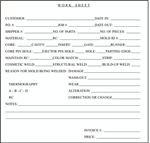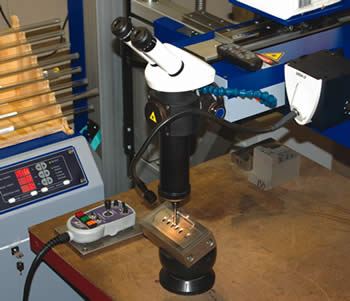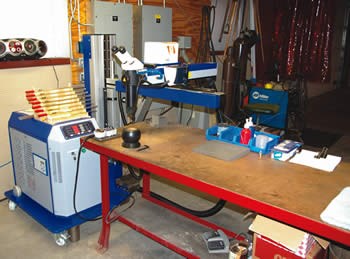In-House Welder Saves Time, Boosts Productivity and Creates New Market Opportunities
Laser welding system increases moldmaker’s ability to meet its customers’ cost and timing demands while also increasing efficiency and output, and creating niche opportunity for mold repair outside its doors.
When Grand Rapids, MI-based Classic Die, Inc.—a builder of plastic injection and vacuum form molds as well as trim dies primarily for the automotive, medical and furniture industries—wanted to trim some time from its design and build processes, the company purchased a laser welding system to not only save time but also to perform mold repair for other moldmakers who got backed up in their own shops.
The company—in business for 30 years and 41 employees strong—has recently been challenged by ever-shortening leadtimes and rising costs. According to Classic Die Plastic Technician/QC Manager Joe Parmeter, adding to these issues is the fact that the company holds tight tolerances on all of its work. “Our tolerances are typically within tenths of thousands,” Parmeter explains. “Finishing can go all the way up to diamond (mirror) finishes.”
Previously the company outsourced its welding, but wanted to move operations in-house for timesaving purposes. “Many of the repairs or engineering changes are not big jobs and take a relatively short amount of time; however some do take longer,” Parmeter comments. “Turnaround time is big with customers and having our own laser welder allows us to turn around mold repairs/engineering changes just that much faster. You can lose a day or two by sending it out. It all boils down to how fast you can turn around a tool for the customer.
Parmeter spent a little over a year researching the various laser welding equipment in the market. “We were in search of a machine that was versatile—able to weld small inserts all the way up to larger mold halves,” Parmeter explains. The HTS Mobile 160 laser welding system—manufactured by O.R. Lasertechnology, Inc. (Elk Grove Village, IL), a provider of laser welding equipment—best fit Classic Die’s requirements. “Price also was a concern, so O.R.’s location really sold us,” Parmeter adds. “They are only three hours away. Anything that I wanted to try in accessories has been provided to me by the next day, and although we haven’t had any issues with our machine, they could be at our place in short order.”
See the Light
According to O.R. Lasertechnology Vice President Jim Kutin, the HTS 160’s open design means there is no weight limit with regards to the mold. “The design of the machine allows the laser welding head be moved around the mold with out any vibration to the microscope and laser delivery—allowing the operator to keep better control of the area that needs to be welded,” he notes. “The system also features a standard X/Y/Z joystick for movement—making it easy for the operator to handle and thus a faster processing time.”
Laser welding, Kutin continues, repairs surface cracks, edges, corners, damaged gates and worn sealing edges with minimum adverse effect to surrounding textured or polished areas—and offers numerous advantages to the moldmaker. First, the work area is easily viewed through the microscope. “Depending on the lenses used, your target spot may be 33/4" to 113/4" from the lens with only the wire (electrode) in the vision field, so your welding area is more exposed,” he explains. “With the controlling of power, pulse duration, pulse time and focal diameter, the laser gives you unsurpassed control of the welding. Using wire a diameter as small as .008 inch, the welding area is extremely precise.”
The area to be repaired may be filled in several operational phases. “With each phase, new material from the filler rods is applied until the final desired surface height is reached,” Kutin notes. “Fusion occurs by focusing the laser beam on the surface. A temperature of 2732°F is achieved at the focal point of the laser. This creates a metallurgical bond between the base and layer materials, which occurs due to the fusing of base material in a thin boundary layer. The material added is created with our special composition that is protected by patent rights. The composition fulfills the metallurgical characteristics for mechanical, tribological, chemical and thermal stress. With an extremely short application of energy (about 10 nanoseconds) we are able to prevent the transfer of heat to areas outside the welding point.”
Additionally, using a laser weld virtually preheating and post-cooling processes—allowing the welder to work at room temperature with cooler substrate material for an improved work environment and a quicker, easier job.
Exceptional Results
Parmeter notes that the “power and versatility” of the machine are a big bonus. “We are able to do small jobs (50 pounds and under) to large jobs that are more than 3,000 pounds,” he states. The laser welding system’s open design also allows Parmeter to weld more quickly. “I can swing the laser arm out from over my table, where I weld small inserts, to an open space where I can weld larger halves on a cart,” he notes.
Additionally, the system is able to add a very small amount of weld without discoloration and heat sink to a tool, Parmeter notes. Currently, he is the only one using the system, and he says there was only a “minimal” learning curve. “A little general welding knowledge helps when welding different kinds of metals,” he advises. “The more you do it, the more you learn.” His newfound laser welding abilities have resulted in more business in tool repair—with other moldmakers outsourcing their work to Classic Die. While the tool repair business does not comprise a large percentage of the company’s profits, Parmeter believe the future looks promising.
Overall, Parmeter is extremely satisfied with the HTS 160. “It has greatly increased our ability to meet customer timing and cost demands—which in turn increases our efficiency and output.”
Related Content
5 Hot Runner Tips for Moldmakers and Molders
Best practices for initial hot runner tryouts and effective preventive maintenance.
Read MoreHands-on Workshop Teaches Mold Maintenance Process
Intensive workshop teaches the process of mold maintenance to help put an end to the firefighting culture of many toolrooms.
Read MoreHow to Overcome Complex Mold Texturing Problems
Key benefits when considering laser technology for mold texturing and repair.
Read MoreHow to Use Scientific Maintenance for More Accurate Mold and Part Troubleshooting
Discover how adopting scientific maintenance approaches helps improve mold lifespan, minimize failures, and optimize production outcomes.
Read MoreRead Next
The Value of a Shop’s Welding Policy
To put the appropriate welding policy in place, you need to choose the right welder—someone who is familiar with tool steel and has a working knowledge of molds.
Read MoreHow to Use Continuing Education to Remain Competitive in Moldmaking
Continued training helps moldmakers make tooling decisions and properly use the latest cutting tool to efficiently machine high-quality molds.
Read MoreReasons to Use Fiber Lasers for Mold Cleaning
Fiber lasers offer a simplicity, speed, control and portability, minimizing mold cleaning risks.
Read More















.jpg;maxWidth=300;quality=90)










